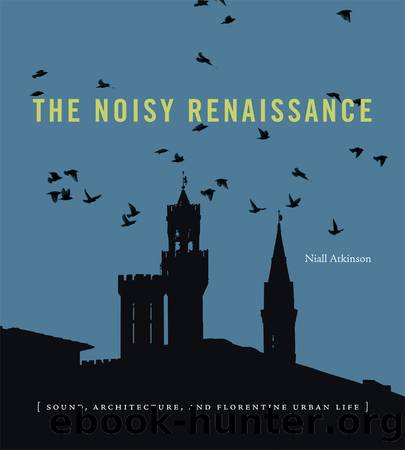The Noisy Renaissance by Niall Atkinson

Author:Niall Atkinson
Language: eng
Format: epub
Publisher: Penn State University Press
FIG. 119 Windows of the Sala dellâUdienza dei Signori, Palazzo Vecchio. Results from the tratte, or the drawing of names by lot for government offices, would be read out to the crowd assembled below in the square. Similarly, in 1494, the result of the priorsâ vote to declare Piero deâ Medici a public enemy was communicated from the window to the citizens. Photo by author.
Anxiety about the inherent instability of a governmentâs ability to maintain acoustic clarity in the face of crisis is comically demonstrated in Sacchettiâs story about Florenceâs war with the papacy of Gregory XI between 1375 and 1378.15 While besieged by mercenary armies, the city of Macerata is inundated by a mighty flood. A woman on her way down to the cellar for wine is suddenly submerged in water and cries out for help, âAccurrâuomo!â As her husband rushes to aid her, he too plunges helplessly into the water, echoing her desperate cry. From here, the cries of frantic neighbors set off a chorus of alarmed voices whose message is transmitted by the cityâs guards until it reaches the central government, where it reverberates not as a call for help but a call to arms: âAllâarme, aliarme!â Rumors rapidly proliferate about the enemy entering the city, alarm bells sound, guards take up arms, townspeople fill the streets, fearful and armed, and descend on the piazza, only to find it barricaded by a nervous government. The noise in the square only grows louder amid fears of imminent violence.
From victims, to guards, through the bureaucracy, to the executive governmentâan individual mishap is transformed into a military invasion, comically underscoring the possible distortions that a damaged soundscape could bring to bear on an unwitting populace already predisposed to the fear of attack. Seeing that no one was coming, the priors attempt to send a message back from the center to the periphery. Needless to say, this message, too, suffers a similar fate as it moves in fits and starts through unreliable means. The story ends with the comical figure of Frate Antonio, trapped under the weight of a large shield and a bell clapper, mistaken for the enemy by a frantic city in complete acoustic disarray. The priors then finally regain their nerve, everyone returns home, and the surrounding towns have much to laugh about. The narrator finishes by mocking the paranoia of a community that, like drunken geese, entangled itself in confusion while losing all semblance of reason.16
In the real world, the flow of official information required a constant repetition of official sounds. In a face-to-face economy, information was transmitted from the mouths, gestures, and visible signs of moving bodies. This underscores the important role that town criers (banditori) played in properly verbalizing official messages in an environment that always contained the potential to distort flows of information.17 In effect, the heralds âmade publicâ (piuvichare) the will of the government in the network of spaces that they helped to constitute as public space.
Storytelling in the Piazza
Overhearing their conversation, we began to delight in his simplicity and in what the youths were saying to him.
Download
This site does not store any files on its server. We only index and link to content provided by other sites. Please contact the content providers to delete copyright contents if any and email us, we'll remove relevant links or contents immediately.
| Africa | Americas |
| Arctic & Antarctica | Asia |
| Australia & Oceania | Europe |
| Middle East | Russia |
| United States | World |
| Ancient Civilizations | Military |
| Historical Study & Educational Resources |
Magic and Divination in Early Islam by Emilie Savage-Smith;(1500)
Ambition and Desire: The Dangerous Life of Josephine Bonaparte by Kate Williams(1344)
Bohemians, Bootleggers, Flappers, and Swells: The Best of Early Vanity Fair by Bohemians Bootleggers Flappers & Swells- The Best of Early Vanity Fair (epub)(1343)
Papillon by Henry Charrière(1309)
Twelve Caesars by Mary Beard(1256)
Operation Vengeance: The Astonishing Aerial Ambush That Changed World War II by Dan Hampton(1135)
What Really Happened: The Death of Hitler by Robert J. Hutchinson(1128)
London in the Twentieth Century by Jerry White(1112)
Time of the Magicians by Wolfram Eilenberger(1088)
The Japanese by Christopher Harding(1086)
Twilight of the Gods by Ian W. Toll(1084)
Lenin: A Biography by Robert Service(1045)
The Devil You Know by Charles M. Blow(985)
A Social History of the Media by Peter Burke & Peter Burke(936)
Freemasons for Dummies by Hodapp Christopher;(922)
Napolean Hill Collection by Napoleon Hill(902)
Henry III by David Carpenter;(891)
The Churchill Complex by Ian Buruma(881)
The Rise and Triumph of the Modern Self by Unknown(878)
